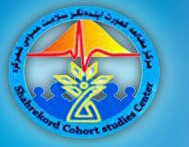The protocol of a population-based prospective cohort study in southwest of Iran to analyze common non-communicable diseases: Shahrekord cohort study
Authors
Affiliations
- 1Modeling in Health Research Center and School of Public Health, Department of Epidemiology and Biostatistics, Shahrekord University of Medical Sciences, Shahrekord, Iran.
- 2Cellular and Molecular Research Center, Shahrekord University of Medical Sciences, Shahrekord, Iran.
- 3Digestive Disease Research Center, Digestive Diseases Research Institute, Tehran University of Medical Sciences, Tehran, Iran.
- 4Center of Molecular and Genetic Epidemiology, Department of Clinical Sciences and Community Health, Università degli Studi di Milano, Milan, Italy.
- 5Modeling in Health Research Center and School of Public Health, Department of Epidemiology and Biostatistics, Shahrekord University of Medical Sciences, Shahrekord, Iran. ali.ahmadi@sbmu.ac.ir.
- 6Clinical Biochemistry Research Center, Shahrekord University of Medical Sciences, Shahrekord, Iran.
Toggle Title
Toggle Content goes here
Abstract
Background: Prospective cohort studies are considered ideal choices to study multiple outcomes and risk factors for Non-communicable diseases (NCDs). Our aim is to set up the protocol and analyzes risk factors, incidence rates, prevalence, trends, and the models of environmental and genetic determinants of NCDs and their outcomes as well as interaction among such determinants.
Methods: Shahrekord cohort study (SCS) is a population-based prospective, study on a cohort consisting of people aged 35-70 years started in November 2015 in Iran. The sample size of the original cohort is at least 10,000 people. Annual follow-ups (200,000 person-year) of the cohort were designed to be conducted up to 2036. Exposures (a detailed demographic, socioeconomic, general health, quality of life, physical activity, anthropometric indexes, stress, health literacy, social capital, nutrition and eating habits, lifestyle, occupational history, living place, blindness, deafness, electrocardiography, lung capacities, blood pressure, sleep, smoking and alcohol, contact to animals, physical examinations and medical history, dental health, used drugs and supplements, glucose and lipid profiles) were measured by relevant standard methods and questionnaires. Incidence of common NCDs (cardiovascular diseases, cancer, gastrointestinal, respiratory, renal, hepatic, accidents, injury and neurological diseases), trend of risk factors, hospitalization, disability, and death were considered the outcomes of the cohort. The definition of disease was determined based on the International Classification of Diseases 10th version (ICD-10). Routine hematologic and biochemical tests were conducted and an all-inclusive biobank (blood, hair, nail, and urine specimens) of the cohort was stored for future studies. All steps of data collection and examinations are directly monitored by the quality control team.
Discussion: The SCS is a unique study conducted in the southwest of Iran that is a notable work given the climate conditions and ethnic population (especially in Bakhtiari) of this region. By providing high-quality protocol and introducing it, the SCS can serve as a solid foundation for management and researchers in southwest Iran. The SCS provides prerequisites for collaboration and regional, national, and international studies on NCDs. Data are available at the modeling in the health research center, Shahrekord University of Medical Sciences, Shahrekord, Iran, for any collaboration.
Keywords: Adults; Cardiovascular disease; Cohort study; Developing countries; Iran; Non-communicable diseases; Risk-factors; Shahrekord.

